Abstract
The arsenic bioavailability in the bed sediments from the Anllóns River (NW Spain) has been assessed by using several analytical approaches. A six-step sequential fractionation was compared to three general availability tests: the Toxicity Characteristic Leaching Procedure (TCLP) extraction, which estimates the leaching potential of As and its effect on the survival of microorganisms (Vibrio fischeri), an extraction with 1 M HCl extraction, which estimates the bioavailability to higher plants, and a physiologically based extraction test (PBET), which estimates the bioavailability to superior animals. Arsenic was found to be mainly associated to the least mobile fractions: bound to Fe-Al oxides and in the residual phase. Among the three single extractants considered, the PBET extracted the highest As concentrations (1–11% of the total As). The TCLP extracts showed toxicity to Vibrio fischeri whereas for the plants evaluated, aqueous extracts did not show adverse effects.


Similar content being viewed by others
References
Adriano, D. C. (2001). Trace elements in terrestrial environments: Biogeochemistry, bioavailability and risks of metals. New York: Springer.
Ashley, P. M., Lottermoser, B. G., & Chubb, A. J. (2003). Environmental geochemistry of the Mt Perry copper mines area, SE Queensland, Australia. Geochemistry, Exploration, Environment, Analysis, 3(4), 345–357.
Besada, V., Schultz, F., & Pombar, L. (2000). Concentración de metales pesados en sedimentos de La Coruña y su plataforma próxima. In A. Duarte, C. Vale, & R. Prego (Eds.), Estudios de Biogeoquímica na Zona Costeira Ibérica (pp. 199–208). Portugal: Universidade de Aveiro.
Boixet, L., Gleeson, C. F., & García, J. (2007). The Corcoesto gold deposit. 23rd Int. Applied Geochemistry Symp. (IAGS 2007) Congress Proc., Oviedo, 14–19 June.
Bose, P., & Sharma, A. (2002). Role of iron in controlling speciation and mobilization of arsenic in subsurface samples. Water Research, 36, 4916–4926.
Carbonell, A. A., Aarabi, M. A., DeLaune, R. D., Gambrell, R. P., & Patrick Jr., W. H. (1998). Arsenic in wetland vegetation: availability, phytotoxicity, uptake and effects on plant growth and nutrition. Science of the Total Environment, 217(3), 189–199.
CICDXLXG (1996). Estudio sobre la actualización del inventario de suelos contaminados. Jerarquización y desarrollo de una legislación para la protección del suelo en Galicia. Consellería de Industria. Xunta de Galicia. Santiago de Compostela.
Dudka, S., & Miller, W. P. (1999). Permissible concentrations of arsenic and lead in soils base don risk assessment. Water Air and Soil Pollution, 113, 127–132.
Filgueiras, A. V., Lavilla, I., & Bendicho, C. (2002). Chemical sequential extraction for metal partitioning in environmental solid samples. Journal of Environmental Monitoring, 4, 823–857.
Guitián, F., & Carballas, T. (1976). Técnicas de Análisis de Suelos. Ed. Pico Sacro, Santiago de Compostela, Spain, 288 pp.
Hettiarachchi, G. M., Pierzynski, G. M., & Ransom, M. (2000). In situ stabilization of soil lead using phosphorus and manganese oxide. Environmental, Science & Technology, 34, 4614–4619.
Jung, M. C., Thornton, I., & Chon, H. T. (2002). Arsenic, Sb and Bi contamination of soils, plants, waters and sediments in the vicinity of the Dalsung Cu-W mine in Korea. Science of the Total Environment, 295, 81–89.
Karczewska, A., Bogda, A., Gałka, B., Szulc, A., Czwarkiel, D., & Duszynìska, D. (2006). Natural and anthropogenic soil enrichment in heavy metals in areas of former metallic ore mining in the Sudety Mts. Polish Journal of Soil Science, 39(2), 131–142.
Kheboian, C., & Bauer, C. (1987). Accuracy of selective extraction procedures for metal speciation in model aquatic sediments. Analytical Chemistry, 50(10), 1417.
Krysiak, A., & Karczewska, A. (2007). Arsenic extractability in the areas of former arsenic mining and smelting, SW Poland. Science of the Total Environment, 379(2–3), 190–200.
Lombi, E., Sletten, R. S., & Wenzel, W. W. (2000). Sequentially extracted arsenic from different size fractions of contaminated soils. Water, Air and Soil Pollution, 124, 319–332.
Luoma, S. N., & Bryan, G. W. (1981). A statistical assessment of the form of trace metals in oxidized estuarine sediments employing chemical extractants. Science of the Total Environment, 17(2), 165–196.
Moalla, S. M. N., Soltan, M. E., Rashed, M. N., & Fawzy, E. M. (2006). Evaluation of dilute hydrochloric acid and acid ammonium oxalate as extractants for some heavy metals from Nile River sediments. Chemical Ecology, 22(4), 313–327.
Moreno, T., Olroyd, A., McDonald, I., & Gibbons, W. (2007). Preferential fractionation of trace metals-metalloids into PM10 resuspended from contaminated gold mine tailings at Rodalquilar, Spain. Water, Air and Soil Pollution, 179, 93–105.
Nolan, A. L., Lombi, E., & McLaughlin, M. J. (2003). Metal bioaccumulation and speciation in soils: why bother with speciation. Australian Journal of Chemistry, 56, 77–91.
Novoa-Muñoz, J. C., Queijeiro, J. M. G., Blanco-Ward, D., Álvarez-Olleros, C., García-Rodeja, E., & Martínez Cortizas, A. (2007). Arsenic fractionation in agricultural acid soils from NW Spain using a sequential extraction procedure. Science of the Total Environment, 378, 18–22.
Rubinos, D., Barral, M. T., Ruiz, B., Ruiz, M., Rial, M. E., & Alvarez, M. (2003). Phosphate and arsenate retention in sediments of the Anllons River (northwest Spain). Water, Science & Technology, 48(10), 159–166.
Ruby, M. V., Davis, A., Schoof, R., Eberle, S., & Sellstone, C. (1996). Estimation of lead and arsenic bioavailability using a physiologically based extraction test. Environmental, Science & Technology, 30(2), 422–430.
Sahuquillo, A., López-Sánchez, J. F., Rauret, G., Ure, A. M., Muntau, H., & Quevauviller, P. H. (2002). Sequential extraction procedures for sediment analysis. In P. H. Quevauviller (Ed.), Methodologies in soil and sediment fractionation studies. Single and sequential extraction procedures (p. 180). Belgium and UK: European Commission.
Sarkar, D., Makris, K. C., Parra-Noonan, M. T., & Datta, R. (2007). Effect of soil properties on arsenic fractionation and bioaccessibility in cattle and sheep dipping vat sites. Environment International, 33, 164–169.
Serfor-Armah, Y., Nyarko, B. J. B., Adotey, D. K., Dampare, S. B., & Adomako, D. (2006). Levels of arsenic and antimony in water and sediment from Prestea, a gold minino town in Ghana and its environments. Water, Air and Soil Pollution, 175, 181–192.
Slowey, A. J., Jonson, S. B., Newville, M., & Brown Jr., G. E. (2007). Speciation and colloid transport of arsenic from mine tailings. Applied Geochemistry, 22, 1884–1898.
Snape, I., Scouller, R. C., Stark, S. C., Stark, J., Riddle, M. J., & Gore, D. B. (2004). Characterisation of the dilute HCl extraction method for the identification of metal contamination in Antarctic marine sediments. Chemosphere, 57, 491–504.
Sonmez, O., & Pierzynski, G. M. (2005). Phosphorus and manganese oxides effects on soil lead bioaccessibility: PBET and TCLP. Water, Air and Soil Pollution, 166, 3–16.
Turner, A., & Olsen, Y. S. (2000). Chemical versus enzymatic digestion of contaminated estuarine sediment: Relative importance of iron and manganese oxides in controlling trace metal bioavailability. Estuarine, Coastal and Shelf Science, 51, 717–728.
USEPA (1992). Method 1311: Toxicity Characteristic Leaching Procedure (TCLP). Washington DC: US Environmental Protection Agency.
USEPA (1998). Land disposal restrictions phase IV: Final rule promulgating treatment standards for metal wastes and mineral processing wastes; mineral processing secondary materials and bevill exclusion issues; treatment standards for hazardous soils, and exclusion of recycled wood preserving wastewaters. Washington DC: US Environmental Protection Agency.
Vangronsveld, J., & Cunningham, S. D. (1998). Introduction to the concepts. In J. Vangrosveld, & S. D. Cunningham (Eds.), Metal contaminated soil (pp. 1–15). New York: Springer.
Wedepohl, K. (1995). The composition of the continental crust. Geochimica et Cosmochima Acta, 59(7), 1217–1232.
Xunta de Galicia (1986). Atlas Geoquímico de Galicia, 8.
Zucconi, F., Forte, M., Monaco, A., & De Bertoldi, M. (1981). Biological evaluation of compost maturity. BioCycle, 22, 27–29.
Acknowledgments
The present study was financed by the Science and Education Ministry of Spain (MEC, REN 2003-08673/BES-2004-5894). Rosa Devesa-Rey was granted with a FPI grant. Remigio Paradelo was granted with a “María Barbeito” grant.
Author information
Authors and Affiliations
Corresponding author
Rights and permissions
About this article
Cite this article
Devesa-Rey, R., Paradelo, R., Díaz-Fierros, F. et al. Fractionation and Bioavailability of Arsenic in the Bed Sediments of the Anllóns River (NW Spain). Water Air Soil Pollut 195, 189–199 (2008). https://doi.org/10.1007/s11270-008-9739-3
Received:
Accepted:
Published:
Issue Date:
DOI: https://doi.org/10.1007/s11270-008-9739-3




